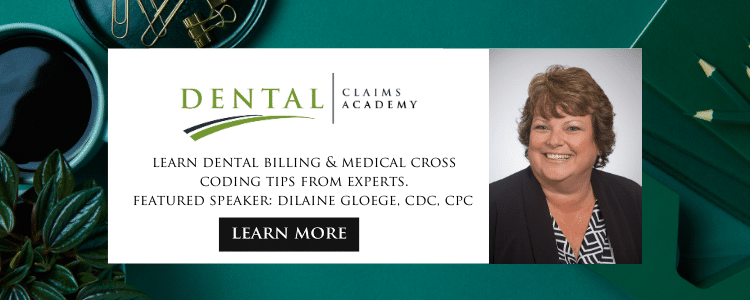Dental Narratives: Why Stock Dental narratives can be Harmful


A narrative in the dental industry is a description of the patient’s problems and procedures. This is something you might see documented in clinical notes or the patient’s medical history. Stock narratives are default descriptions that cover a wide variety of symptoms, problems and procedures. Think of it like a “default” setting on your phone.
You may believe there is nothing wrong with it and that it’s just convenient. Our team of dental billing experts at Dental ClaimSupport get it, you don’t want to write a specific narrative for every single patient. You’re busy, you’re overwhelmed and don’t want to add extra tedious tasks to your day. Unfortunately, using stock dental narratives can get you and your practice in trouble.
In this article, you’ll discover why using stock dental narratives can hurt you in the long run and why it’s important to always write a personal, specific narrative for each patient. It may not be fun, but it’s a necessary and time consuming task. Taking a few extra minutes to do so is definitely worth keeping your practice and your dental license.
What is a stock dental narrative?
As mentioned above, a stock dental narrative is a catch-all. It’s a pre-written narrative that includes some key buzz-words that insurance companies can pick up on and determine how much of the cost of the procedure they will cover.
It could be a narrative that someone used for a previous patient that you got paid for, so you want to use the same description again. For insurance companies, reimbursement is based on proving medical necessity. Each narrative needs to include the reason the procedure was required and the patient’s condition prior to the procedure, proving the medical necessity.
Think of it like you are telling a patient’s story. Instead of using diagnosis codes, like is required on the medical claim, you would create a written narrative using everyday words. What is the patient’s problem? Why was this procedure or prescription necessary? What did you, as a dentist, do to solve this problem? Did this procedure produce the anticipated outcome?
It’s the equivalent of getting into a car wreck and the claim adjuster comes out to see the damages. They take photos and notes of everything wrong with your car and submit this to the insurance company. What if they submitted generic photos that don’t really portray what happened to your car? They could use photos they already had on file to get more money. That seems wrong, right? Well, that is exactly what stock dental claim narratives are.
What are the consequences of using stock dental narratives?
Using stock dental narratives is never a good idea because it can lead to fraudulent claims and reimbursement to a practice that was not entitled to receive one. Fraudulent claims can lead to a suspended dental license, a revoked dental license, a civil and/or criminal lawsuit or even prison.
This seems like such an obvious thing to avoid… Why are we even talking about it?
Well, because the use of stock dental narratives is more common than you think. It is the easier way to fill out narratives. It cuts down on claim submission time and brings in more money for the practice. For example, you don’t have to think about the percentage of the tooth that is damaged. It’s easier! Dentists could be doing it to make the patient happier, making them think more of their treatment is being covered by insurance.
Some offices may not even realize they’re doing it. They may think they are simply using the same structure in every narrative, which is okay, but you HAVE to make every narrative unique to each patient.
There are templates that you can use, but there are also guidelines for these templates. If a claim reviewer begins noticing that all of your narratives are identical, it is going to raise a red flag and cause the practice to be audited. This means your payments are not going to come in because everything is going to be on hold to be reviewed with scrutiny.
They will start digging into everything, ask for documentation on everything, proving exactly what you say in these narratives is true. If you’re wrong on any of this, because it’s on a healthcare record, you are committing healthcare fraud and prison may be in your future.
Eliminate fines and fees by educating yourself on dental insurance administration
It is a fact that the more educated you are on a topic, the less likely you are to make mistakes surrounding the topic. That may seem obvious and silly to point out, but using stock dental narratives are just one example where practices don’t even know they’re making a mistake.
Some people are aware of these laws and guidelines, and still choose to make the mistake of replicating narratives on every patient’s medical record, and usually it is because they want to make more money. If that’s the case, there is not much we can do about these people other than assume they will suffer the consequences.
However, for those who are not aware of these laws, knowledge is power. Dental ClaimSupport has webinars available for those wishing to educate themselves on codes and guidelines, such as proper narrative writing. Make sure you are aware of any rules in the dental billing industry you are questioning and avoid messes that you didn’t even mean to make through learning more at Dental Claims Academy.

Related Posts
Dental revenue resources from Dental Claim Support
